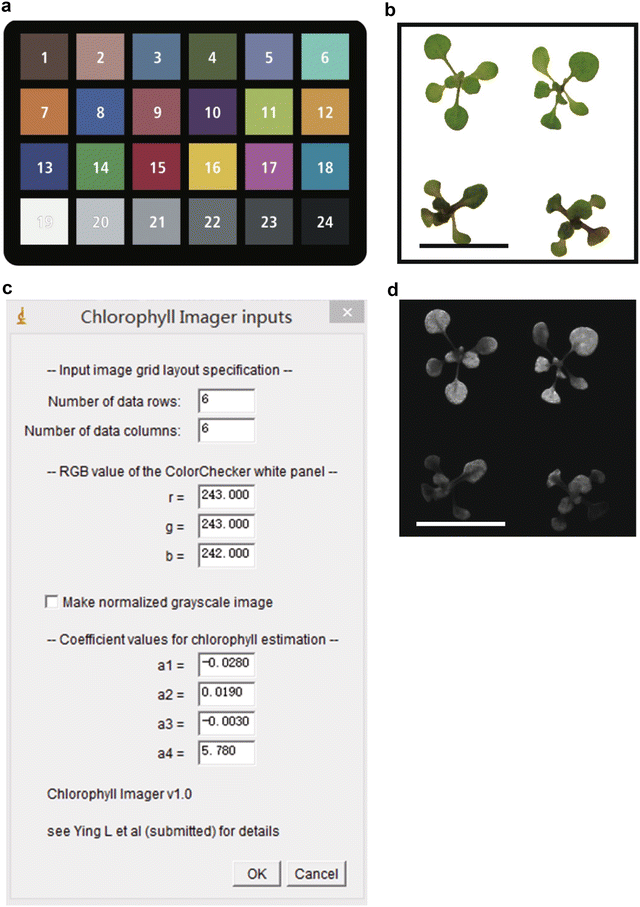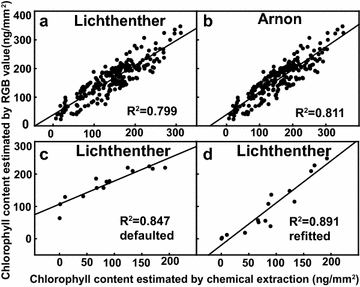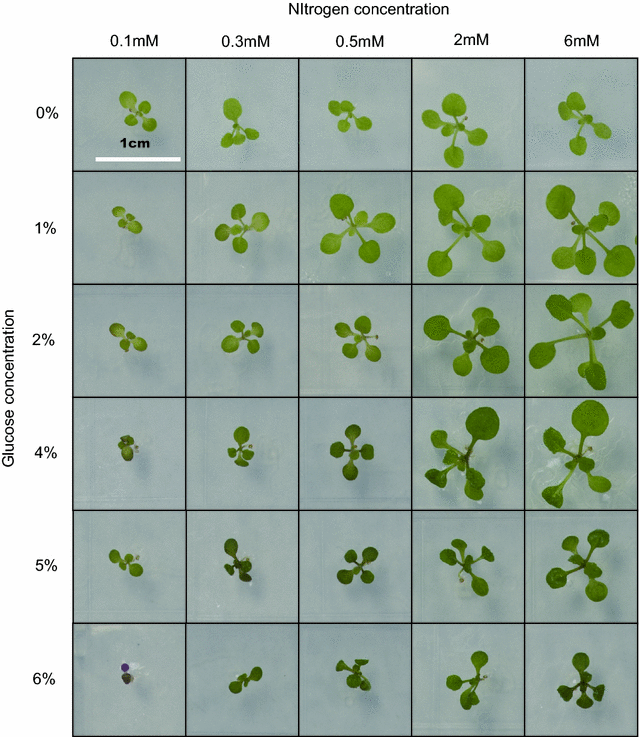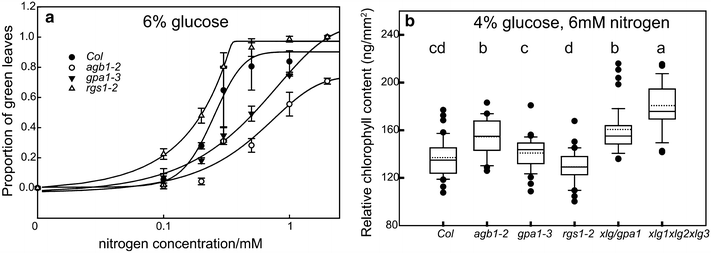A nondestructive method to estimate the chlorophyll content of Arabidopsis seedlings
- PMID: 28416964
- PMCID: PMC5391588
- DOI: 10.1186/s13007-017-0174-6
A nondestructive method to estimate the chlorophyll content of Arabidopsis seedlings
Abstract
Background: Chlorophyll content decreases in plants under stress conditions, therefore it is used commonly as an indicator of plant health. Arabidopsis thaliana offers a convenient and fast way to test physiological phenotypes of mutations and treatments. However, chlorophyll measurements with conventional solvent extraction are not applicable to Arabidopsis leaves due to their small size, especially when grown on culture dishes.
Results: We provide a nondestructive method for chlorophyll measurement whereby the red, green and blue (RGB) values of a color leaf image is used to estimate the chlorophyll content from Arabidopsis leaves. The method accommodates different profiles of digital cameras by incorporating the ColorChecker chart to make the digital negative profiles, to adjust the white balance, and to calibrate the exposure rate differences caused by the environment so that this method is applicable in any environment. We chose an exponential function model to estimate chlorophyll content from the RGB values, and fitted the model parameters with physical measurements of chlorophyll contents. As proof of utility, this method was used to estimate chlorophyll content of G protein mutants grown on different sugar to nitrogen ratios.
Conclusion: This method is a simple, fast, inexpensive, and nondestructive estimation of chlorophyll content of Arabidopsis seedlings. This method lead to the discovery that G proteins are important in sensing the C/N balance to control chlorophyll content in Arabidopsis.
Keywords: Arabidopsis thaliana; C/N sensing; Chlorophyll content; ColorChecker chart; Heterotrimeric G protein complex; Stress assay.
Figures




Similar articles
-
Non-destructive evaluation of chlorophyll content in quinoa and amaranth leaves by simple and multiple regression analysis of RGB image components.Photosynth Res. 2014 Jun;120(3):263-72. doi: 10.1007/s11120-014-9970-2. Epub 2014 Jan 19. Photosynth Res. 2014. PMID: 24442792
-
[Effects of drought on leaf growth and chlorophyll fluorescence kinetics parameters in Cyclobalanopsis glauca seedlings of Karst areas].Ying Yong Sheng Tai Xue Bao. 2019 Dec;30(12):4071-4081. doi: 10.13287/j.1001-9332.201912.001. Ying Yong Sheng Tai Xue Bao. 2019. PMID: 31840451 Chinese.
-
Nondestructive Optical Sensing of Flavonols and Chlorophyll in White Head Cabbage (Brassica oleracea L. var. capitata subvar. alba) Grown under Different Nitrogen Regimens.J Agric Food Chem. 2016 Jan 13;64(1):85-94. doi: 10.1021/acs.jafc.5b04962. Epub 2015 Dec 28. J Agric Food Chem. 2016. PMID: 26679081
-
Relationship between leaf optical properties, chlorophyll fluorescence and pigment changes in senescing Acer saccharum leaves.Tree Physiol. 2016 Jun;36(6):694-711. doi: 10.1093/treephys/tpv148. Epub 2016 Feb 29. Tree Physiol. 2016. PMID: 26928514
-
Mild ammonium stress increases chlorophyll content in Arabidopsis thaliana.Plant Signal Behav. 2015;10(3):e991596. doi: 10.4161/15592324.2014.991596. Plant Signal Behav. 2015. PMID: 25853545 Free PMC article.
Cited by
-
Marvels of Bacilli in soil amendment for plant-growth promotion toward sustainable development having futuristic socio-economic implications.Front Microbiol. 2023 Dec 7;14:1293302. doi: 10.3389/fmicb.2023.1293302. eCollection 2023. Front Microbiol. 2023. PMID: 38156003 Free PMC article.
-
Seedling Chloroplast Responses Induced by N-Linolenoylethanolamine Require Intact G-Protein Complexes.Plant Physiol. 2020 Sep;184(1):459-477. doi: 10.1104/pp.19.01552. Epub 2020 Jul 14. Plant Physiol. 2020. PMID: 32665332 Free PMC article.
-
Generating Reproducing Anoxia Conditions for Plant Phenotyping.Bio Protoc. 2023 Feb 5;13(3):e4603. doi: 10.21769/BioProtoc.4603. eCollection 2023 Feb 5. Bio Protoc. 2023. PMID: 36816988 Free PMC article.
-
A novel PGPF Penicillium olsonii isolated from the rhizosphere of Aeluropus littoralis promotes plant growth, enhances salt stress tolerance, and reduces chemical fertilizers inputs in hydroponic system.Front Microbiol. 2022 Oct 27;13:996054. doi: 10.3389/fmicb.2022.996054. eCollection 2022. Front Microbiol. 2022. PMID: 36386667 Free PMC article.
-
Multifarious Characterization and Efficacy of Three Phosphate-Solubilizing Aspergillus Species as Biostimulants in Improving Root Induction of Cassava and Sugarcane Stem Cuttings.Plants (Basel). 2023 Oct 20;12(20):3630. doi: 10.3390/plants12203630. Plants (Basel). 2023. PMID: 37896093 Free PMC article.
References
-
- Steele MR, Gitelson AA, Rundquist DC. A comparison of two techniques for nondestructive measurement of chlorophyll content in grapevine leaves. Agron J. 2008;100:779. doi: 10.2134/agronj2007.0254N. - DOI
Grants and funding
LinkOut - more resources
Full Text Sources
Other Literature Sources
Research Materials

